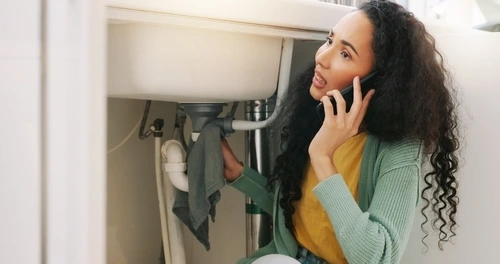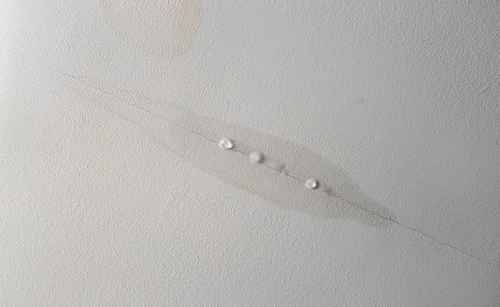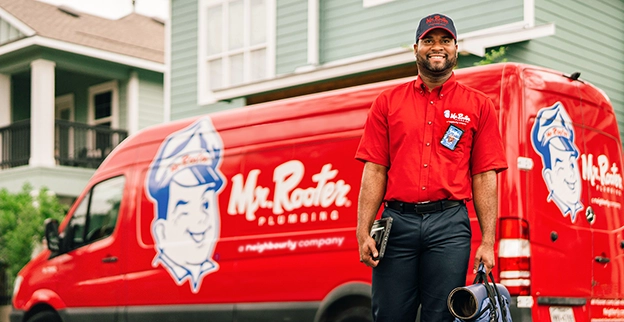Mr. Rooter Plumbing® experts recommend addressing these common plumbing emergencies right away:
|

No hot water, low pressure, and a ceiling leak? Oh my! A shower that slows to a drizzle, a tap that never gets hot, or water dripping from the ceiling aren’t just frustrations — they’re clear warning signs your plumbing is calling for help.
The tricky part is knowing which problems can wait and which ones need a plumber right away. In this article, we’ll walk through the three biggest red flags homeowners should never ignore and what to do when they appear.
How to Know It’s Time to Call a Plumber
Every homeowner deals with little plumbing quirks — a dripping tap or a toilet that runs now and then. Most of the time, those can wait. But when a plumbing problem starts to affect your whole home, interrupt your hot water, or cause a water leak, that’s when it crosses the line into an emergency.
While there are several common plumbing emergencies that require urgent attention, the three top indicators of a problem are:
- Low water pressure throughout the home (not just one sink or shower)
- No hot water in the house
- Stains, sagging, or active dripping from the ceiling.
Addressing these issues early can mean the difference between a quick repair and costly damage.
1. Low Water Pressure Throughout the Home

A shower that barely sprays or taps that only trickle aren’t just inconvenient — they’re often signs that you need a plumber for low water pressure.
Common causes of low water pressure include:
- Aging pipes that have corroded or narrowed
- Mineral buildup or sediment clogging supply lines
- Frozen or partially frozen pipes during winter cold snaps
- Municipal supply issues that affect your whole neighbourhood
- Hidden leaks in walls, ceilings, or underground lines
First, try a couple of quick checks: Make sure your shutoff valves are fully open, clean faucet aerators to clear debris, and ask a neighbour if they’re experiencing the same thing. If you’re unsure where those parts are, our home plumbing systems guide can help you understand the basics.
If the pressure stays low, schedule a visit from a plumber for low water pressure. They can test your regulator, check for a hidden water leak, and confirm whether the problem comes from your plumbing or the municipal supply.
Addressing low pressure early matters. It can reveal leaks before they turn into ceiling stains or burst pipes — problems that are especially common in colder climates where freeze-thaw cycles put extra stress on plumbing systems.
2. No Hot Water in the House
Few things throw off your day faster than turning on the tap and realizing there’s no hot water in the house. Unlike running out of hot water quickly, this isn’t just about a long shower. A complete loss of hot water usually points to a problem with your water heater.
Common causes of a loss of hot water include:
- A tripped breaker or blown fuse on electric water heaters
- An extinguished pilot light on gas water heaters
- A faulty thermostat or heating element
- Sediment buildup inside the tank that prevents efficient heating
Internal damage or leaks in an older water heaterFirst, confirm that the breaker hasn’t flipped, make sure the pilot light is lit, and listen for unusual noises from the tank. If everything looks normal but there’s still no hot water in the house, the problem usually requires professional repair.
3. A Water Leak or Burst Pipe in the Ceiling

A water leak or burst pipe in the ceiling isn’t just inconvenient — it’s an emergency that can damage your home quickly.
Common signs of a ceiling water leak:
- Brown or yellow stains spreading across ceilings
- Sagging drywall or bubbling paint
- A musty odour or damp feeling in the room
- Active dripping or water pooling overhead
These are not surface-level problems. Water weakens drywall, damages insulation, and can even create fire risks if it reaches wiring. Freeze-thaw cycles put extra stress on pipes, making bursts a common culprit behind ceiling leaks.
If you notice these signs, shut off your main water valve immediately and clear the space beneath the leak. Even a small drip can hide a much larger issue above the ceiling, and professional pipe leak repair and replacement are often needed to prevent long-term damage.
What to Do Before Your Plumber Arrives
When a plumbing emergency strikes, the minutes before help arrives can make a big difference. Acting quickly protects your home, reduces damage, and helps your plumber get straight to work.
- Shut off the main water valve.
- Turn off power or gas to the water heater if needed.
- Document leaks or damage with photos or video.
- Move valuables away from affected areas.
- Clear access so repairs can start right away.
These steps are simple but effective. Turning off water and power keeps your home safe, documenting damage helps with insurance, and clearing space makes the repair process faster. By handling these basics, you give your plumbing professional the best chance to solve the problem quickly.
Ready for Help? Contact Mr. Rooter Plumbing Today

If you’re dealing with low water pressure, no hot water, or a ceiling leak, help is only a call away. Having a trusted professional on your side can make the difference between a quick repair and costly damage.
At Mr. Rooter Plumbing®, our service professionals are known for their courteous, knowledgeable approach and upfront pricing. Every job is backed by the Neighbourly Done Right Promise®, so you can trust that your plumbing issue will be fixed the right way, the first time.
Explore our plumbing services and schedule an appointment with your local Mr. Rooter team today.
This article is intended for general informational purposes only and may not be applicable to every situation. You are responsible for determining the proper course of action for your home and property. Mr. Rooter is not responsible for any damages that occur as a result of this blog content or your actions. For the most accurate guidance, contact the Mr. Rooter location nearest you for a comprehensive, on-site assessment.
FAQs About Common Plumbing Issues
Mr. Rooter Plumbing is a one-stop solution for all your plumbing service needs. Whether you need a pipe repaired, clogs cleared, or drains cleaned, you can count on our experienced team to get the job done right! Our commitment to exceptional service includes answering your questions. Here are answers to some of your most frequently asked questions on common plumbing problems.
Should I call a plumber for low water pressure?
Yes. Low water pressure in the whole home usually indicates a more significant issue, such as aging pipes, mineral buildup, or a hidden leak. If only one fixture is affected, the issue may be minor, but when every tap produces weak flow, it’s time to call a plumber.
Should I call a plumber if there’s no hot water in the house?
If there’s no hot water in the house, first check the breaker (for an electric water heater), the pilot light (for a gas water heater), or the water heater’s thermostat. If the problem continues, it’s time to call for repair. A complete heat loss often points to a water heater failure, which requires professional repair.
Do ceiling leaks always mean a burst pipe?
Not always, but ceiling leaks are never minor. Stains, sagging drywall, or dripping water may signal a burst or damaged pipe. Because water spreads quickly and can damage wiring, shut off your main valve immediately and call for plumbing repair.
Does home insurance cover burst pipes or water leaks in Canada?
Many policies cover sudden damage from burst pipes, but may not cover slow water leaks or maintenance issues. Check your policy, document all damage, and promptly report the issue to your insurer. Acting quickly helps with both coverage and repair.
Should I repair or replace a water heater with no hot water?
If the heater is under 8–10 years old and the fix is simple, repair is often best. Older units, frequent breakdowns, or visible water leaks usually mean replacement is more cost-effective. If possible, inspect and replace your water heater before winter to ensure reliable hot water. Request service from your local Mr. Rooter team today.

